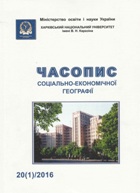Integration of romani people, as the most important internal political problems of Hungary
Abstract
The intense population growth of romani people as a result of which every tenth Hungarian citizen will be romani within a few years. However, in contrast of the aging Hungarian society romani population represents a youthful group which unambiguously seems more-and-more significant both in political and human resource aspects. It is generally known that a considerable proportion of Romani people inHungarylive on welfare grants. This, besides that the social and economic integration of romani people, the so-called “romani issue” became a hot political issue, also means a serious burden on the society. This is due to the differences in values, their problems in erudition and mode of life, the bias of the majority of citizens against romani people which can be eliminated or at least reduced by accelerating integration processes. The authors believe that the socio-geographical studies of Romani people, besides the remarkable sociological and romological achievements so far, can give an efficient tool for identifying and solving the problems.
Downloads
References
2. Botlik, Zs. (2012): Cigányok (romák) Európában. – Földgömb 6, pp. 10-11.
3. Csalag, Zs. (1973): Etnikum? Faj? Réteg? Adalékok a „cigányság” fogalmához, Világosság, 1. sz.
4. Erdős, K. (1989): A magyarországi cigányság (1958).-In: Erdős Kamill cigánytanulmányai (Szerk. Vekerdi J.) A Gyulai Erkel Ferenc Múzeum kiadványai, Békéscsaba, pp. 42-56.
5. Ferge, Zs. (2001): A magyarországi szegénységről. – INFO-Társadalomtudomány 15., pp. 17-26.
6. Fónai, M. – Vitál, A. (2008): A tiszavasvári magyarcigány és oláhcigány lakosság szociális helyzete és egészségi állapota. – Falu 4, pp. 63-82.
7. Forray, R.K. (szerk.) (2000): Romológia-Ciganológia. – Dialóg Campus Kiadó, Budapest-Pécs, 314 p.
8. Glatz, F. (szerk.) (1999): A cigányok Magyarországon – Magyarország az ezredfordulón, MTA, Dabas Jegyzet Kft, AliPrint Bt., Budapest, 269 p.
9. Gyergyói, S. (szerk.) (1990): Kirekesztéstől a beilleszkedésig I.-II. kötet, Mozaik Kiadó Iroda, Piremon Nyomda, Debrecen, 691 p.
10. Hablicsek, L. (2007): Kísérleti számítások a roma lakosság területi jellemzőinek alakulására és 2021-ig történő előrebecslésére. – Demográfia 1, pp. 7-54.
11. Havas, G. (1982): A baranyai teknővájó cigányok – Cigányvizsgálatok (szerk. Andor M.) Művelődéskutató Intézet, Budapest.
12. Kemény, I. (1997) A magyarországi roma (cigány) népességről, Magyar Tudomány 6. sz., pp.644-656
13. Kemény, I. (2004): A magyarországi cigány népesség demográfiája.Demográfia, 3-4.
14. Kemény, I. (szerk.) (1976): Beszámoló a magyarországi cigányok helyzetével foglalkozó 1971-ben végzett kutatásokról, MTA Szociológiai Kutató Intézet, Budapest, 40 p.
15. Kemény, I. – Janky, B. (2003): A cigány nemzetiségi adatokról. – Kisebbségkutatás, 2, pp. 309-315.
16. Kemény, I. – Janky, B. – Lengyel, G: (2004): A magyarországi cigányság 1971-2003. – Gondolat Kiadó, 192 p.
17. Kertesi, G. (2000): A cigány foglalkoztatás leépülése és szerkezeti átalakulása 1984 és 1994 között. Közgazdasági Szemle, 5., pp. 406-443.
18. Kertesi, G. (2005): Roma foglalkoztatás az ezredfordulón – a rendszerváltás maradandó sokkja. Szociológiai Szemle, 2., pp. 57-87.
19. Kertesi, G. – Kézdi, G. (1998): A cigány népesség Magyarországon – Dokumentáció és adattár, Socio-typ., Budapest.
20. Kertesi, G. – Kézdi, G. (2009): Néhány adat a magyarországi roma népességről. Avialable at: http://hvg.hu/itthon/200908_Nehany_adat_a_magyarorszagi_roma_nepessegro?s=jobline, Letöltve: 2013. január 31.
21. Kocsis, K. – Kovács, Z. (1999): A cigány népesség társadalomföldrajza – Magyarország az ezredfordulón MTA, Budapest, pp. 13-19.
22. Lengyel, G. (2004): Részletek Tiszavasvári cigányságának népességleírásából. Kisebbségkutatás 2, pp. 316-343.
23. Molnár J. (2015): Néhány gondolat a magyarországi romák interkulturális stratégiájáról. – In: Geográfus körút (Keczeli L. – Kovács I. – Nezdei Cs. szerk.), Virágmandula Kft., Pécs, pp. 195-216.
24. Musinka, A. – Kolesárová, J. (2012): Situation of the Roma in Slovakia and their status in the contemporary Slovak Society. – In: Roma population the peripheries of theVisegradcountries (Edited by J. Pénzes and Zs. Radics). Didakt Kft., Debrecen, pp. 104-118.
25. A Magyarországon 1893. Január 31-én Végrehajtott Czigány Összeírás Eredményei. – Magyar Statisztikai Közlemények Új folyam IX. kötet. Athenaeum Társulat, Budapest, p. 59.
26. Pálóczi, Á. (2013): Main Social Issues Related to the Integration of Gypsiesin Borsod-Abaúj-Zemplén County. – In: Regional Development and Cross Border Cooperation, Editura UniversităŃii din Oradea, pp. 46-52.
27. Pénzes, J. – Pásztor, I.Z. (2014): Romák Magyarországon. A Földgömb, 11, szám pp. 17-18.
28. Süli-Zakar, I. (2012a): A cigányság integrációjának szociálgeográfiai alapjai (A roma népesség demográfiai robbanása és migrációja a XXI. századi Európa nagy kihívása) – In: Tiszteletkötet Dr. Kormány Gyula egyetemi magántanár 80. születésnapjára (Szerk.: Dr. Frisnyák S. – Dr. Kókai S.) – Nyíregyháza, pp. 255-271.
29. Süli-Zakar, I. (2012b): The question of the roma’s integrationin Europe and Hungary. – In: Roma population on the peripheries of the Visegrad Countries (Spatial Trends and Social Challenges) (Eds. J. Pénzes – Zs. Radics) – Debrecen, pp. 9-31.
30. Süli-Zakar, I. – Pálóczi, Á. – Szabó, D. (2012): Social geographical conditions for the integration of the Roma pop-ulation. – In.: Roma population on the peripheries of the Visegradcountries (Eds.: J. Pénzes – Zs. Radics) Debrecen, pp. 28-53
31. Süli-Zakar, I. – Czimre, K. – Pálóczi, Á. (2014): Social Frontiers between the Roma Minorities and Mainstream Populationin Southeast Europe (The Rough Ways of the Roma Integration) In.: EUROLIMES. Volume XVII., Oradea University Press, Oradea, pp. 146-168.
32. Süli-Zakar, I. (2015): A magyarországi cigányság népesség földrajzi vizsgálata. – In: Tiszteletkötet Dr. Gál András geográfus 60. születésnapjára, Kapitális Nyomdaipari és Kereskedelmi Kft., Nyíregyháza-Szerencs, pp. 531-553.
33. Tátrai, P. (2014): Etnikai folyamatok Magyarországon az ezredforduló után. – Területi Statisztika, 54 (5), pp. 506-523.
34. Virág, T. (2006): A gettósodó térség. Szociológiai Szemle, 1., pp. 60-76.




